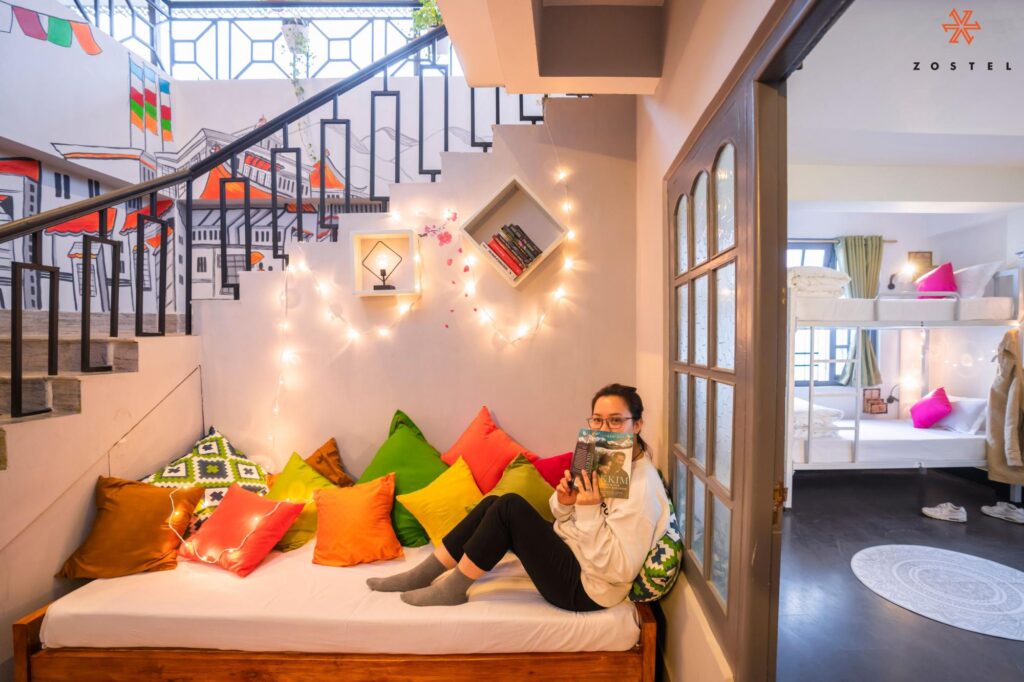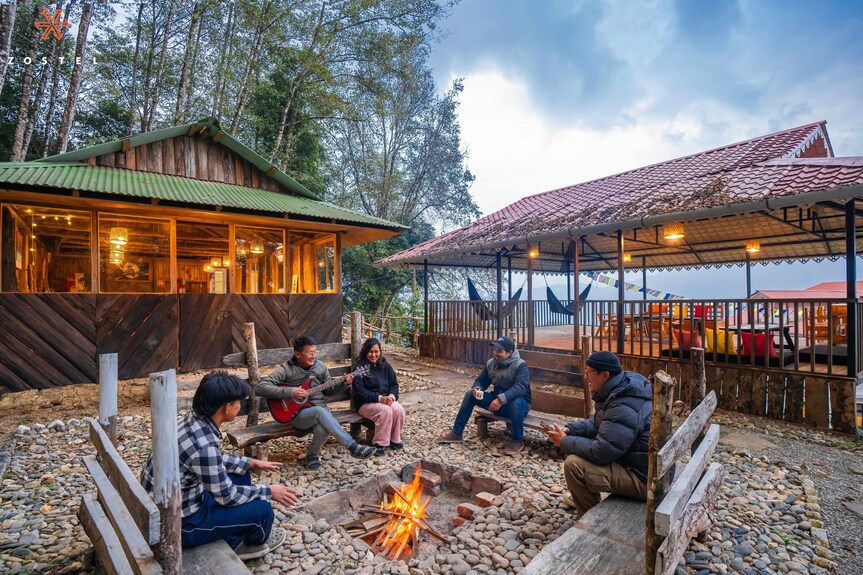Looking for how to start a hostel in Sikkim? This guide walks you through the market, legal steps, costs, design, marketing, and the best places to open—so you can go from idea to first booking with confidence.
TL;DR
- Where to open: Gangtok (MG Marg/Tadong/Development Area), Pelling/Kaluk–Rinchenpong, Yuksom, Namchi, Ravangla, Lachung/Lachen (seasonal), Zuluk/Nathang (Silk Route), Rumtek/Sang, Aritar/Mankhim.
- Model: 24–40 beds (mixed dorms + a couple of privates) + café + experiences.
- Approvals: Business incorporation → trade license → tourism/ lodging registration → FSSAI for café → fire safety NOC → Shops & Establishments → GST/ESI/EPF as applicable.
- Reality check: Land purchase for non-locals is restricted—use leases, adaptive reuse, JVs, or concessions and get a local legal opinion early.
Sikkim, with its snow-capped mountains, vibrant monasteries, and warm hospitality, has become one of India’s most loved travel destinations. As tourism grows rapidly in Gangtok, Pelling, Namchi, and North Sikkim, many entrepreneurs are looking to set up hostels and homestays to cater to backpackers, solo travelers, and culture-seekers.
Why Start a Hostel in Sikkim?

- Booming Tourism: Sikkim attracts lakhs of domestic and international tourists every year.
- Budget Travel Trend: Travelers, especially youth and backpackers, prefer affordable hostels and homestays over luxury hotels.
- Government Support: Sikkim’s Department of Tourism actively promotes registered homestays and eco-friendly accommodations.
- Cultural Exchange: Hosting travelers is not just a business—it’s also a way to share Sikkim’s culture, cuisine, and traditions.
Understand the Market (Seasonality & Demand)
- Season peaks: March–June, Oct–Dec (high demand, higher ADR).
- Shoulder/low: Monsoon (Jul–Sep) and late winter (Jan–Feb) vary by circuit; North and high-altitude routes can shut unpredictably.
- Guest mix: Backpackers, domestic road-trippers, foreign trekkers, remote workers (short stints), bikers on the Silk Route, and nature/wellness travelers.
Positioning options
- Adventure/trekking base • Social backpacker hub • Wellness/quiet workation • Culture & monastery circuit • Photography/astro nights.
Choose Your Hostel Model & Capacity
Core setup (starter):
- Beds: 24–40 total (6–10 beds per dorm, mixed + female-only).
- Private rooms: 2–4 (queen + twin).
- Common areas: Lounge + coworking table + café/pantry + terrace/yard.
- Essentials: 24/7 hot water, fast Wi-Fi, lockers & privacy curtains, bedside lights/outlets, laundry corner, drying line, secure gear room.
Add-on revenue
Guided walks/treks, bike rentals, airport/bus transfers, café/brunch nights, workshops (fermentation, thangka, photography), yoga mornings.
Understand the Legal Requirements
A. Homestay & Hostel Registration
Under the Sikkim Registration of Tourist Trade Act, all hostels, homestays, and guesthouses must be registered with the Department of Tourism and Civil Aviation. Without registration, operating is considered illegal.
Key Rules:
- You must be the owner and resident of the property.
- The property should offer 1 to 5 guest rooms for accommodation.
- Lease-based or sublet properties are not allowed.
B. Documents Required
To apply, you’ll need:
- Completed Homestay/Hostel Registration Form (HSR-1)
- Proof of ownership (sale deed, land certificate)
- Identity proof (COI, residential certificate, Aadhaar, voter ID)
- Floor plan of the property
- No Objection Certificate (NOC) from Gram Panchayat or Municipality
- Fire safety and sanitation certificates
- Passport-size photographs
- Guest register & bill book setup
C. Validity & Fees
- Registration is valid for 1 year and must be renewed annually.
- Fees vary: approx. ₹3,000 for silver category, ₹5,000 for gold category (plus GST).
Obtain a Trade License
Alongside tourism registration, you’ll need a Trade License from the local municipal body. This license ensures your hostel complies with health, safety, and zoning laws.
- Valid for one financial year (April–March)
- Renewal required every year
- Processing time: 7–15 working days in urban areas
Prepare Your Hostel for Guests
Essential Facilities
- Comfortable rooms with clean bedding, towels, toiletries
- Safe drinking water, reliable electricity, and proper ventilation
- Fire extinguisher, first-aid kit, and waste disposal system
- Wi-Fi, seating area, and common dining/lobby space
Eco-Friendly Practices
Sikkim is an eco-sensitive state, so travelers and authorities value sustainable practices:
- Segregated waste bins
- Solar lighting or water heating where possible
- Water conservation measures
- No single-use plastic
Service Standards
- Maintain a guest register for verification
- Display tariffs and house rules clearly
- Provide authentic Sikkimese food options (optional but attractive for tourists)
Financial Planning & Taxes
- Hostel earnings are subject to income tax
- If annual turnover crosses the GST threshold, GST registration may be required
- Keep records of income and expenses for smooth compliance
Costs & Example Unit Economics (Starter 36-Bed Model)
Capex (lease/rental model, adaptive reuse):
- Basic civil & paint: ₹4–6 lakh
- Bunks, mattresses, linens, lockers (36 beds): ₹4–6 lakh
- 2–4 private rooms setup: ₹3–5 lakh
- Café/pantry & common areas: ₹3–5 lakh
- Electrical, Wi-Fi, cameras, small appliances: ₹2–4 lakh
- Fire/safety, signage, licenses & professional fees: ₹1.5–3 lakh
Estimated capex: ₹17–29 lakh (property-dependent)
Monthly opex (illustrative):
- Rent/lease: ₹60k–₹1.5L (location-dependent)
- Staff (3–5 ppl staggered): ₹80k–₹1.6L
- Utilities & internet: ₹25k–₹45k
- Linen/laundry/consumables: ₹20k–₹40k
- Marketing/commissions & misc: ₹25k–₹60k
Estimated opex: ₹2.1L–₹4.1L
Revenue sketch:
- Beds: 36 beds × ₹800 blended ADR × 55% OCC × 30d ≈ ₹4.75L
- Privates: 3 rooms × ₹3,200 ADR × 55% OCC × 30d ≈ ₹1.58L
- Café/Experiences: ₹60k–₹1.2L
Total: ₹6.9L–₹7.5L (steady state) → EBITDA depends on rent & staffing discipline.
Improve resilience with direct bookings, retreats, and shoulder-season packages.
Marketing & Promotion
Foundations
- Google Business Profile (photos, hours, attributes), Apple Maps, Bing Places.
- OTA play: Start with 2–3 (don’t join all); maintain parity, then drive direct bookings via WhatsApp & website offers.
- Instagram + Reels of views, rooms, community nights; UGC repost + creator stays.
Programs
- Workation weeks: vlogger/creator residencies in low season.
- Experience calendar: weekly city walks, monastery visits, sunrise hikes, cardamom farm tour.
- Partner stack: trek operators, bike rentals, café swaps, yoga teachers, co-working hubs in Siliguri/Gangtok.
SEO content (for your site/blog)
- “Best hostels in Gangtok for solo travelers”
- “Yuksom trek base guide: permits, gear, stays”
- “Silk Route biker’s checklist + stays”
- “How to reach Pelling from NJP/Bagdogra”
- “Monastery circuit near Gangtok: Rumtek, Ranka, Enchey”

Government Support
Once registered, your hostel will be listed on the official Sikkim Tourism website and promoted during tourism fairs. You may also be eligible for training programs and subsidies.
Online Visibility
- List your hostel on OTA platforms like Booking.com, Airbnb, Hostelworld, and MakeMyTrip
- Use Google My Business for local visibility
- Create an Instagram page with photos of your property, local culture, and guest experiences
Local Partnerships
- Collaborate with local taxi operators, trek organizers, and tour guides
- Offer bundled packages (stay + trek, stay + cultural experience)
Challenges to Keep in Mind
- Seasonal fluctuations (monsoons often bring fewer tourists)
- Remote area connectivity issues
- Need for consistent cleanliness and guest service standards
- Annual renewals of licenses and registrations
Best Locations to Open a Hostel in Sikkim
| Area / Circuit | Why it Works | Ideal Guest | Seasonality | Typical Bed/Privates (₹) | Notes |
|---|---|---|---|---|---|
| Gangtok (MG Marg / Development Area / Tadong) | Capital city, transit hub, cafés, nightlife, permits/services close by | Backpackers, road-trippers, remote workers | Year-round; peaks Mar–Jun, Oct–Dec | Beds 600–1,200 • Privates 2,500–4,500 | Walkable access matters; car approach/parking is a plus |
| Pelling & Kaluk–Rinchenpong (West) | Kanchenjunga views, monasteries, skywalk; calmer than Gangtok | Couples, backpackers, photographers | Strong in spring & autumn | Beds 600–1,000 • Privates 2,200–4,000 | Great for terrace/common-area views |
| Yuksom (West) | Trekking gateway (Dzongri/Goecha La), heritage vibe | Trekkers, adventure groups | Peak around trek seasons | Beds 700–1,200 • Privates 2,500–4,500 | Partner with certified guides; gear storage a must |
| Namchi (South) | Emerging city, attractions (Temi Tea, ropeway) | Families, road-trippers | Stable; peaks on holidays | Beds 500–900 • Privates 2,000–3,800 | Good for café + tours to tea estates |
| Ravangla / Borong (South) | Buddha Park, misty valleys, birding | Wellness, photographers | Spring/autumn strong | Beds 500–900 • Privates 2,000–3,800 | Wellness/quiet-stay positioning works |
| Lachen / Lachung (North) | Base for Gurudongmar/Yumthang | Adventure, bucket-list | Highly seasonal; weather-dependent | Beds 700–1,400 • Privates 2,800–5,000 | Permits for guests; plan for cold-weather utilities |
| Zuluk / Nathang (Silk Route, East) | High-altitude hairpins, biker favorite | Bikers, landscape lovers | Clear-sky months; winters harsh | Beds 700–1,300 • Privates 2,800–5,000 | Simple, rugged aesthetics; heating & oxygen awareness |
| Rumtek / Sang (near Gangtok) | Monastery circuit, quieter than city | Culture, remote workers | Year-round | Beds 600–1,000 • Privates 2,200–4,000 | Great if you want calm + proximity to Gangtok |
| Aritar / Mankhim (East) | Lake & ridge views, offbeat | Families, photographers | Spring/autumn | Beds 500–900 • Privates 2,000–3,800 | Offbeat brand + sunrise deck = win |
Ranges are indicative and vary by street, property quality, and season. In hill towns, approach road, view, sunlight, and water can matter as much as the pin on the map.
Operations & SOPs
- Front desk: 7am–10pm staffed; late self check-in SOP; ID verification & permits where required.
- Housekeeping: Daily commons; dorms alternate-day deep clean; linen schedule; pest-proof pantry.
- Café: Limited, high-margin menu; breakfast sets; local ingredients; FSSAI display.
- Safety: Fire drills, extinguisher checks, emergency contacts; snow/landslide alerts by circuit.
- Guest experience: Orientation map at check-in; WhatsApp concierge; feedback loop before checkout.
90-Day Launch Plan
Days 1–15: Market/feasibility, shortlist buildings, draft lease/JV, brand concept & name, basic financial model.
Days 16–30: Legal entity, trade license initiation, tourism registration prep, FSSAI (if café), fire NOC checklist.
Days 31–60: Light renovation, bunks/lockers order, Wi-Fi/electrical, signage, brand shoot, OTA contracts, website + payments.
Days 61–75: Soft launch of café/commons, staff training, trial stays, fix SOP gaps.
Days 76–90: Full listing go-live, Google/Instagram push, partner tie-ups, opening offers, first community night.
Final Thoughts
Starting a hostel business in Sikkim is a rewarding venture if you combine proper registration, quality service, and smart marketing. With tourism on the rise, budget accommodations are in high demand—and Sikkim’s friendly culture makes it the perfect destination for a thriving hostel.
By following the legal requirements, setting up eco-friendly facilities, and actively promoting your hostel, you can build a sustainable and profitable business that also helps showcase Sikkim’s charm to the world.
✅ Pro Tip: Focus on authentic experiences—local food, guided village walks, cultural nights, and eco-friendly practices. These make your hostel stand out and attract long-term travelers who spread word-of-mouth recommendations.
FAQs About Starting a Hostel in Sikkim
1. Can outsiders start a hostel business in Sikkim?
Generally, homestay/hostel registration requires the property owner to be a permanent resident of Sikkim. Outsiders can still invest but may need to partner with a local resident or set up under special agreements.
2. How long does it take to get the registration certificate?
Typically, the process takes 15–30 days, including inspection by tourism officials.
3. What is the difference between a hostel and a homestay in Sikkim?
- Homestay: Owner-occupied, 1–5 rooms, family-style hospitality.
- Hostel/Guesthouse: Larger setup with dorms or multiple rooms, may not be strictly family-run but still needs registration under Tourism rules.
4. Do I need GST registration for a hostel in Sikkim?
GST is required only if your annual turnover exceeds the government’s threshold limit (₹20 lakh for small states like Sikkim).
5. What are the best locations in Sikkim to start a hostel?
- Gangtok: High footfall, year-round demand.
- Pelling & Yuksom: Popular with trekkers and nature lovers.
- Lachen & Lachung: Perfect for adventure travelers heading to Gurudongmar and Yumthang.
- Namchi & Ravangla: Spiritual and cultural tourism hubs.
6. Can I get government support or subsidies?
Yes. Registered homestays may receive training, promotion, and sometimes financial incentives under Sikkim tourism development schemes.

